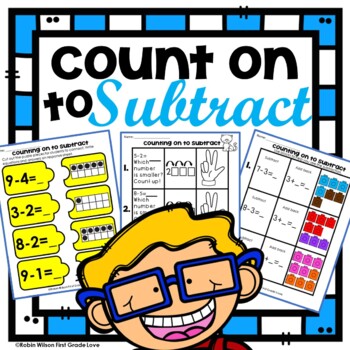Count on to Subtract First Grade
Robin Wilson First Grade Love
1.8k Followers
Grade Levels
K - 2nd, Homeschool
Subjects
Resource Type
Standards
CCSS1.OA.A.1
CCSS1.OA.B.3
CCSS1.OA.B.4
CCSS1.OA.C.5
CCSS1.OA.C.6
Formats Included
- PDF
- Easel Activity
Pages
34 pages
Robin Wilson First Grade Love
1.8k Followers
Easel Activity Included
This resource includes a ready-to-use interactive activity students can complete on any device. Easel by TPT is free to use! Learn more.
What educators are saying
These were fantastic for my firsties! I was able to use these to differentiate and modify for my students as needed and were not confusing for my students to pick up and get to work!
Description
Teach Count on To Subtract First Grade to your students using these fun and engaging digital and PDF worksheets. This concept is simple subtraction by starting with the smallest number and counting up. In Count on To Subtract, you will find several ways to teach this subtraction concept, including blocks, finger tricks, hopping with arrows, subtraction puzzles and more!
Count on to Subtract First Grade includes:
Terms, Suggestions, Standards
- Fingers trick
- Add back
- Practice problems
- Linking cubes
- Ten frames
- Puzzles b/w
- Puzzles color
- Response sheets
- Subtract with different color linking cubes
- Credits
Please leave feedback for credit towards future purchases.
Total Pages
34 pages
Answer Key
N/A
Teaching Duration
N/A
Last updated Sep 3rd, 2021
Report this resource to TPT
Reported resources will be reviewed by our team. Report this resource to let us know if this resource violates TPT’s content guidelines.
Standards
to see state-specific standards (only available in the US).
CCSS1.OA.A.1
Use addition and subtraction within 20 to solve word problems involving situations of adding to, taking from, putting together, taking apart, and comparing, with unknowns in all positions, e.g., by using objects, drawings, and equations with a symbol for the unknown number to represent the problem.
CCSS1.OA.B.3
Apply properties of operations as strategies to add and subtract. If 8 + 3 = 11 is known, then 3 + 8 = 11 is also known. (Commutative property of addition.) To add 2 + 6 + 4, the second two numbers can be added to make a ten, so 2 + 6 + 4 = 2 + 10 = 12. (Associative property of addition.)
CCSS1.OA.B.4
Understand subtraction as an unknown-addend problem. For example, subtract 10 – 8 by finding the number that makes 10 when added to 8.
CCSS1.OA.C.5
Relate counting to addition and subtraction (e.g., by counting on 2 to add 2).
CCSS1.OA.C.6
Add and subtract within 20, demonstrating fluency for addition and subtraction within 10. Use strategies such as counting on; making ten (e.g., 8 + 6 = 8 + 2 + 4 = 10 + 4 = 14); decomposing a number leading to a ten (e.g., 13 - 4 = 13 - 3 - 1 = 10 - 1 = 9); using the relationship between addition and subtraction (e.g., knowing that 8 + 4 = 12, one knows 12 - 8 = 4); and creating equivalent but easier or known sums (e.g., adding 6 + 7 by creating the known equivalent 6 + 6 + 1 = 12 + 1 = 13).






